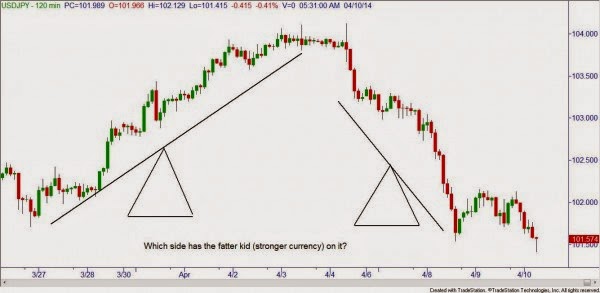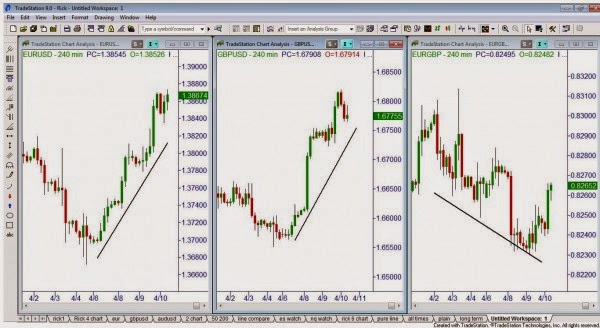Hello traders! This week I will try to explain a bit about relative strength between individual currencies, help you choose which pair to trade, and suggest a couple of rules for your trading plan.
In the classes that I teach, obviously the topic of charts comes up, along with which currency is getting stronger vs. another when looking at the chart. An easy (and somewhat politically incorrect) way of remembering how the charts work is to think about a teeter totter or see-saw from our childhood playgrounds. When looking at that teeter totter from the side, if the right side is pointing up, the kid on the left side of the teeter totter is fatter than the kid on the right side. In the currency market, the base (currency on the left) is getting stronger than the quote (currency on the right). If the teeter totter is pointing down, the kid on the right side of the teeter totter is fatter than the kid on the left, which in forex means the quote is strengthening vs. the base currency.

One technique shown in class is how to compare individual currencies by looking at several different pairs that have the currency in it. With the US dollar, we have the US dollar index which can give us an idea how strong or weak our US dollar is. But if you want to judge the British Pound for example, one technique is to look at the GBP vs. several different currencies to gauge the GBP strength. Chart the EURGBP, GBPJPY, GBPCAD, GBPAUD, GBPCHF, etc. If the GBP is on the fat kid’s side of the teeter totter on most of the charts, you can assume that the GBP is relatively strong vs. most currencies, which might mean you would look for long trades of the GBP.
Another way to use our fat kid on the teeter totter playground analogy is when choosing an individual pair to trade. Say, for example, your trading plan allows you to enter one trade at a time. You are looking at the EURUSD pair and the GBPUSD pair, but are unable to choose which pair to trade. Which one should make you the most pips? My suggestion is to figure out who is the fattest kid (strongest currency) on the playground and who is the skinniest kid (weakest currency.) In the following three charts we are having a teeter totter contest, with each kid being paired up one at a time vs. the other kids.

In the first chart, the EURUSD, who is the fatter kid? If you answered the EUR, you are correct! Give the EUR one point. In the middle chart, the GBPUSD, who is the fatter kid? If you answered GBP, you are correct, give the GBP one point. In the third chart, the EURGBP, who is the fatter kid? If you answered GBP, you are correct! Give the GBP another point. So what is the final tally? GBP 2, EUR 1, USD 0. On our imaginary playground, the GBP is the fattest kid (strongest currency) and the USD is the skinniest kid (weakest currency.) So the trade that should make the most pips is the GBPUSD.
Before we get too much further, I do want to mention the lines drawn on the charts. I was using the trend line tool to draw in the lines, but to you experienced traders out there you know the trend lines weren’t drawn as tradeable trend lines, just as teeter totter examples! So please, no angry emails about drawing trend lines wrong!
Another note about using this technique to judge relative strength. In the core strategy, we teach to buy in quality demand zones and sell in quality supply zones, trading in the direction of the larger time frame trend. When using the recommended three time frames (large time frame for trend, medium time frame for zones, small time frame for entry), which of your time frames should you use to compare the relative strength of your currencies? If you said the large time frame, give yourself a point!
As promised, our last topic is a couple of potential rules for your trading plan and I hope you have one written out! If you have never been to one of our classes, a trading plan is a set of self-determined rules that you will follow to hopefully make some pips in this market. If you have no plan, your chance of success is severely limited. A few things that need to be in your plan are risk management rules, trading strategies, how you will continue your learning process, etc.
My first suggested rule is geared primarily to new traders. The rule is stated as “I will enter only one position at a time. When my stop loss is at break even or better on this first trade, I can then enter a second position. A third position will only be entered when the stop on the second position is at break even or better.” A second rule could be that you have no more than three forex positions on at one time for your first 30-60 days of trading. The main reason for this is that new traders often get stressed out when trying to manage multiple positions. Why add unnecessary stress to your trading career?
I hope these techniques will help you make a few more pips in the forex market, so until next time.
Rick can be contacted on this link: Rick Wright
In the classes that I teach, obviously the topic of charts comes up, along with which currency is getting stronger vs. another when looking at the chart. An easy (and somewhat politically incorrect) way of remembering how the charts work is to think about a teeter totter or see-saw from our childhood playgrounds. When looking at that teeter totter from the side, if the right side is pointing up, the kid on the left side of the teeter totter is fatter than the kid on the right side. In the currency market, the base (currency on the left) is getting stronger than the quote (currency on the right). If the teeter totter is pointing down, the kid on the right side of the teeter totter is fatter than the kid on the left, which in forex means the quote is strengthening vs. the base currency.

One technique shown in class is how to compare individual currencies by looking at several different pairs that have the currency in it. With the US dollar, we have the US dollar index which can give us an idea how strong or weak our US dollar is. But if you want to judge the British Pound for example, one technique is to look at the GBP vs. several different currencies to gauge the GBP strength. Chart the EURGBP, GBPJPY, GBPCAD, GBPAUD, GBPCHF, etc. If the GBP is on the fat kid’s side of the teeter totter on most of the charts, you can assume that the GBP is relatively strong vs. most currencies, which might mean you would look for long trades of the GBP.
Another way to use our fat kid on the teeter totter playground analogy is when choosing an individual pair to trade. Say, for example, your trading plan allows you to enter one trade at a time. You are looking at the EURUSD pair and the GBPUSD pair, but are unable to choose which pair to trade. Which one should make you the most pips? My suggestion is to figure out who is the fattest kid (strongest currency) on the playground and who is the skinniest kid (weakest currency.) In the following three charts we are having a teeter totter contest, with each kid being paired up one at a time vs. the other kids.

In the first chart, the EURUSD, who is the fatter kid? If you answered the EUR, you are correct! Give the EUR one point. In the middle chart, the GBPUSD, who is the fatter kid? If you answered GBP, you are correct, give the GBP one point. In the third chart, the EURGBP, who is the fatter kid? If you answered GBP, you are correct! Give the GBP another point. So what is the final tally? GBP 2, EUR 1, USD 0. On our imaginary playground, the GBP is the fattest kid (strongest currency) and the USD is the skinniest kid (weakest currency.) So the trade that should make the most pips is the GBPUSD.
Before we get too much further, I do want to mention the lines drawn on the charts. I was using the trend line tool to draw in the lines, but to you experienced traders out there you know the trend lines weren’t drawn as tradeable trend lines, just as teeter totter examples! So please, no angry emails about drawing trend lines wrong!
Another note about using this technique to judge relative strength. In the core strategy, we teach to buy in quality demand zones and sell in quality supply zones, trading in the direction of the larger time frame trend. When using the recommended three time frames (large time frame for trend, medium time frame for zones, small time frame for entry), which of your time frames should you use to compare the relative strength of your currencies? If you said the large time frame, give yourself a point!
As promised, our last topic is a couple of potential rules for your trading plan and I hope you have one written out! If you have never been to one of our classes, a trading plan is a set of self-determined rules that you will follow to hopefully make some pips in this market. If you have no plan, your chance of success is severely limited. A few things that need to be in your plan are risk management rules, trading strategies, how you will continue your learning process, etc.
My first suggested rule is geared primarily to new traders. The rule is stated as “I will enter only one position at a time. When my stop loss is at break even or better on this first trade, I can then enter a second position. A third position will only be entered when the stop on the second position is at break even or better.” A second rule could be that you have no more than three forex positions on at one time for your first 30-60 days of trading. The main reason for this is that new traders often get stressed out when trying to manage multiple positions. Why add unnecessary stress to your trading career?
I hope these techniques will help you make a few more pips in the forex market, so until next time.
Rick can be contacted on this link: Rick Wright
Last edited by a moderator:
